sensor SSANGYONG TURISMO 2013 Service Manual
[x] Cancel search | Manufacturer: SSANGYONG, Model Year: 2013, Model line: TURISMO, Model: SSANGYONG TURISMO 2013Pages: 796, PDF Size: 78.99 MB
Page 559 of 796
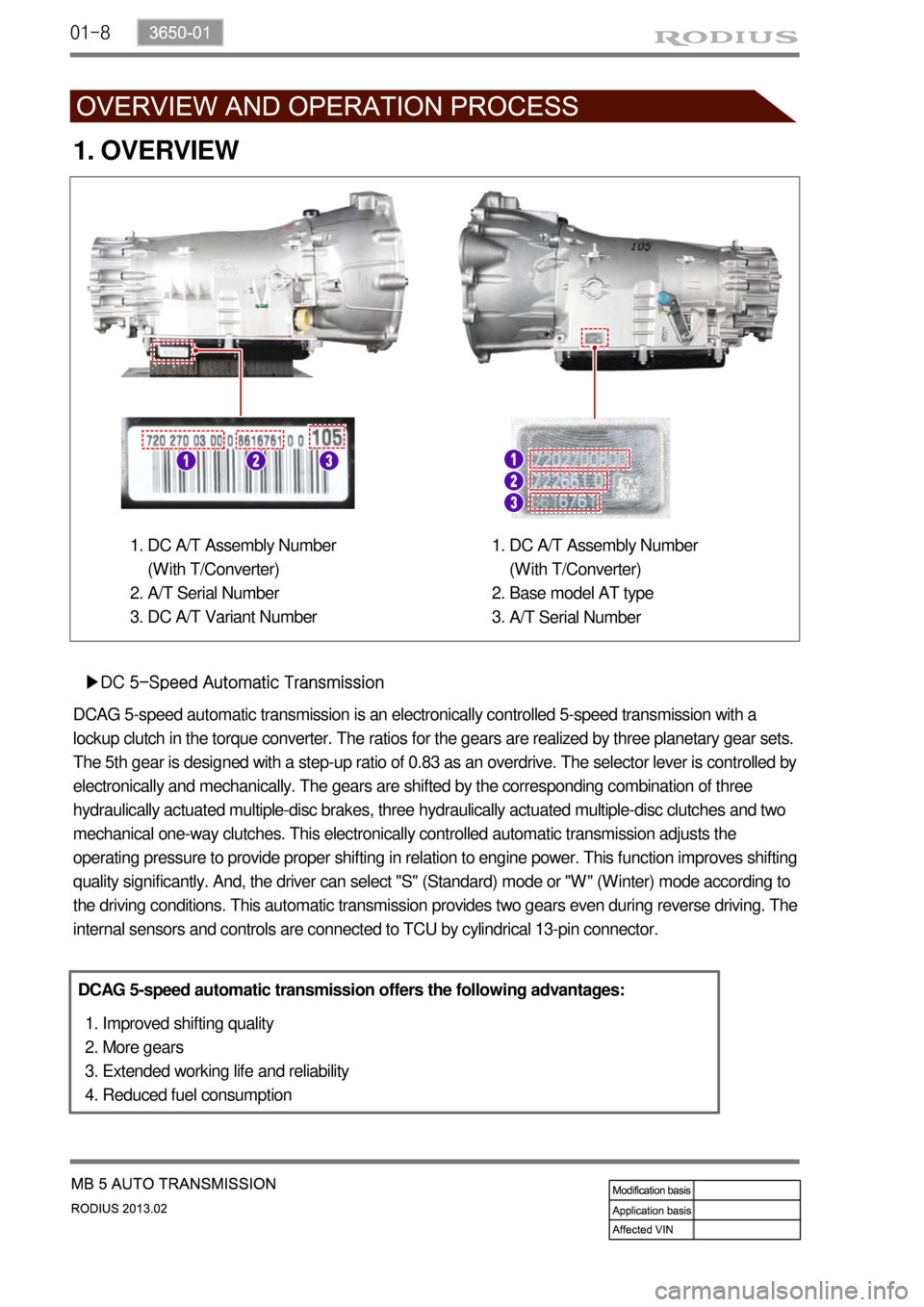
01-8
1. OVERVIEW
▶DC 5-Speed Automatic Transmission
DCAG 5-speed automatic transmission is an electronically controlled 5-speed transmission with a
lockup clutch in the torque converter. The ratios for the gears are realized by three planetary gear sets.
The 5th gear is designed with a step-up ratio of 0.83 as an overdrive. The selector lever is controlled by
electronically and mechanically. The gears are shifted by the corresponding combination of three
hydraulically actuated multiple-disc brakes, three hydraulically actuated multiple-disc clutches and two
mechanical one-way clutches. This electronically controlled automatic transmission adjusts the
operating pressure to provide proper shifting in relation to engine power. This function improves shifting
quality significantly. And, the driver can select "S" (Standard) mode or "W" (Winter) mode according to
the driving conditions. This automatic transmission provides two gears even during reverse driving. The
internal sensors and controls are connected to TCU by cylindrical 13-pin connector.
DCAG 5-speed automatic transmission offers the following advantages:
Improved shifting quality
More gears
Extended working life and reliability
Reduced fuel consumption 1.
2.
3.
4.
DC A/T Assembly Number
(With T/Converter)
A/T Serial Number
DC A/T Variant Number 1.
2.
3.DC A/T Assembly Number
(With T/Converter)
Base model AT type
A/T Serial Number 1.
2.
3.
Page 570 of 796
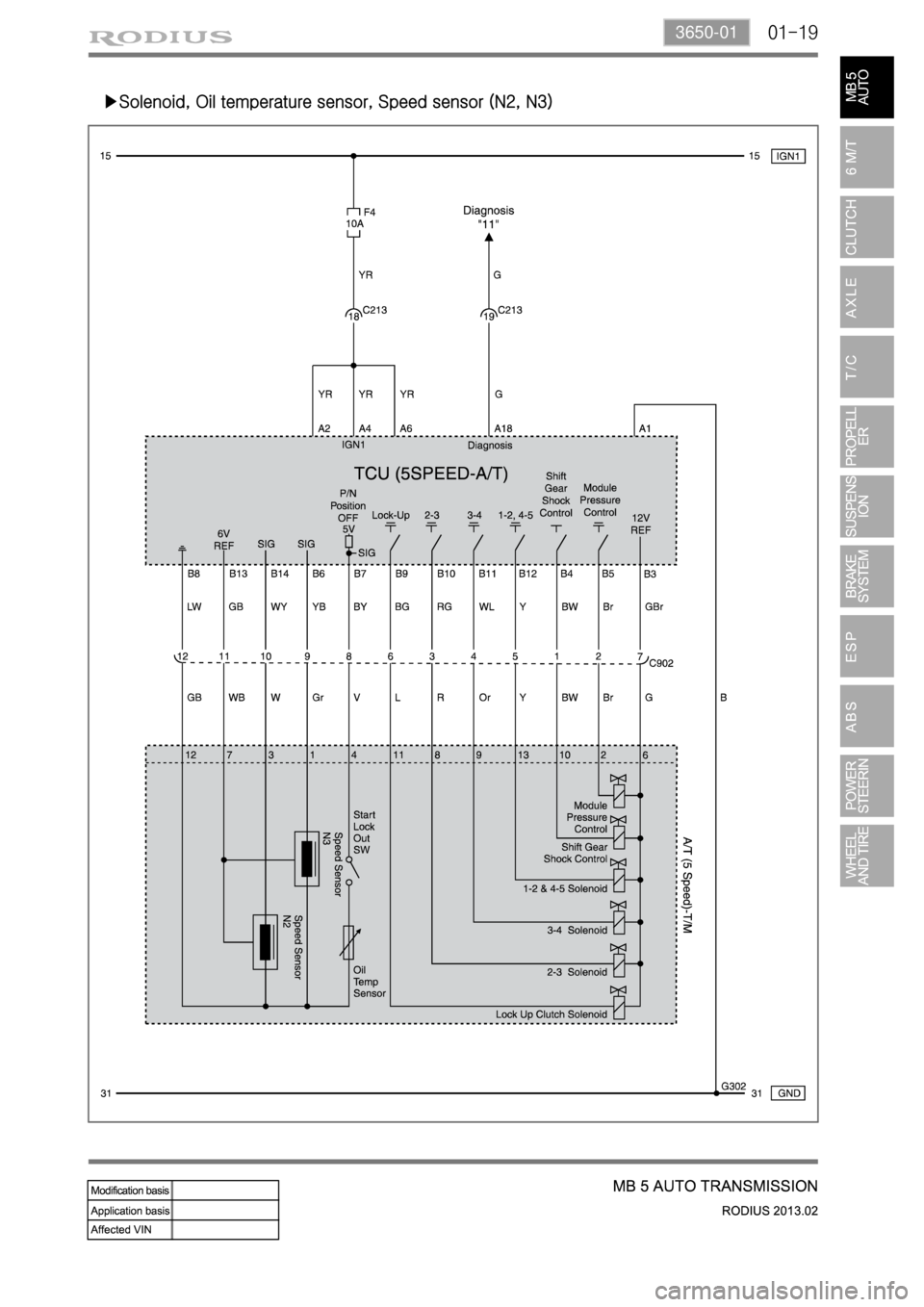
01-193650-01
▶Solenoid, Oil temperature sensor, Speed sensor (N2, N3)
Page 630 of 796
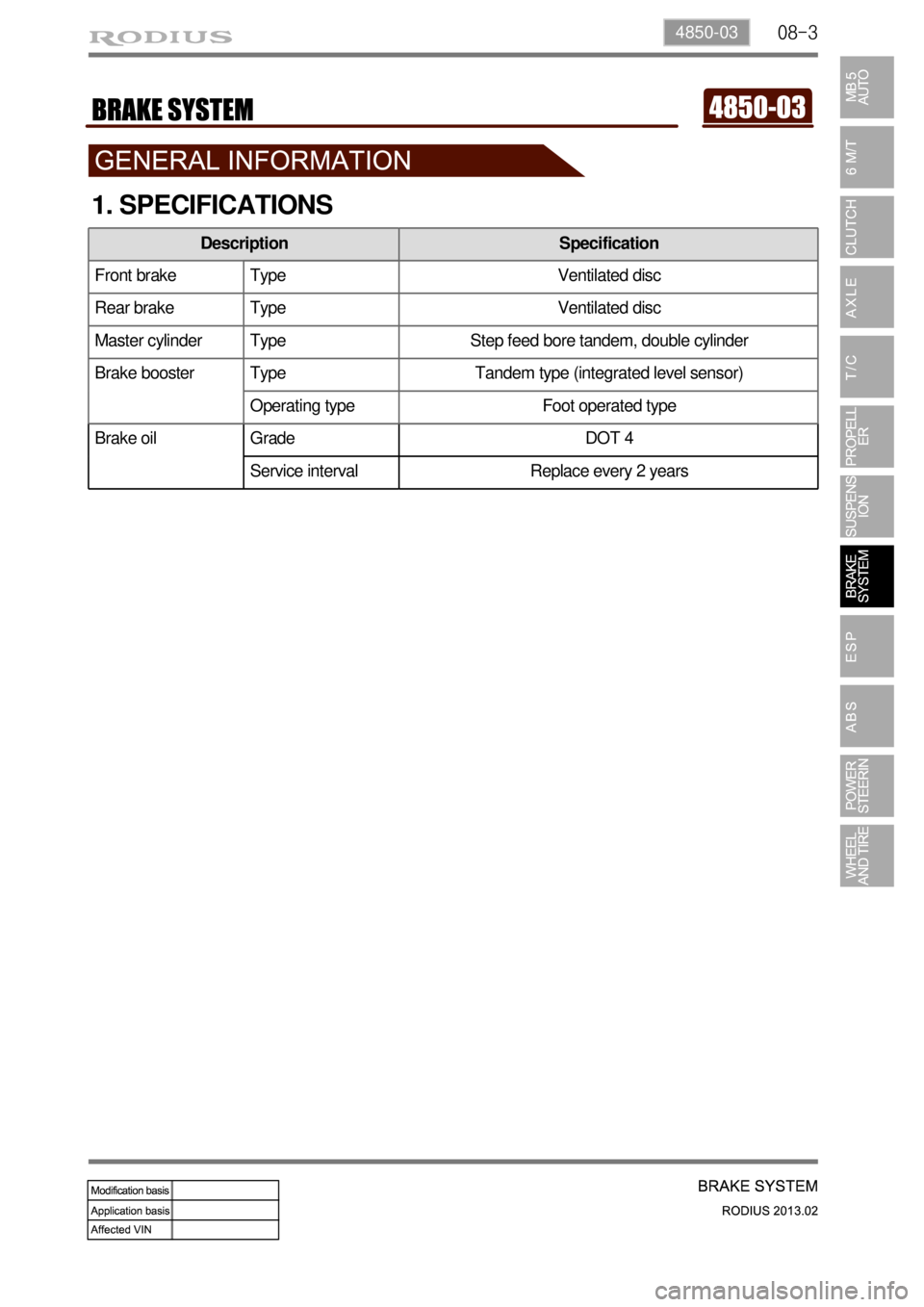
08-34850-03
Brake oil Grade DOT 4
Service interval Replace every 2 years
1. SPECIFICATIONS
Description Specification
Front brake Type Ventilated disc
Rear brake Type Ventilated disc
Master cylinder Type Step feed bore tandem, double cylinder
Brake booster Type Tandem type (integrated level sensor)
Operating type Foot operated type
Page 649 of 796

09-34891-01
1. SPECIFICATIONS
1) Pressure Sensor
UnitDescription
Location
ABS ESP
HECU
(Hydraulic &
Electronic Control
Unit) CPU:MCU60 (32bit)
Clock Frequency:
28 MHz
Memory: 128~256 KB CPU:MCU60 (32bit)
Clock Frequency:
28 MHz
Memory:256~512 KB Under the front washer
reservoir
Wheel Speed
SensorActive type wheel speed
sensorActive type wheel speed
sensorOn each wheel
Front air gap:
0.3 ~ 1.3mm,
Rear air gap:
0.3 ~ 1.3 mm
Steering Wheel
Angle SensorN/AMaximum angular speed:
1500°/sec
Operating voltage:
9~16 VUnder the steering
wheel
Sensor ClusterN/AIntegrated with yaw rate
sensor and lateral sensorUnder the audio
assembly
Pressure Sensor
N/A Analog outputUnder the master
cylinder
Description Specification
Supplying voltage approx. 5 V (4.75~5.25 V)
Max. pressure 350 bar
Page 650 of 796

09-4
2) Sensor Cluster
3) Steering Wheel Angle Sensor
Air gap between sensor and rotorFront 0.3 ~ 1.3 mm
Rear 0.3 ~ 1.3 mm
Current (at 2.75 km/h)IHIGH : 14 mA
ILOW : 7 mA
Voltage (when turning the steering wheel one turn per second) 7.5 ~ 20 V
4) Active Wheel Speed Sensor
Operating voltage 9~16 V
Maximum output current 10 mA
Max. current consumption100 ma
Maximum detection angle speed 1500˚/s
Operating temperature -30~75℃
Supplying voltage 9 to 16 V (battery voltage)
Description Specification
Description Specification
Description Specification
Supplying voltage approx. 5 V (4.75~5.25 V)
Output voltage while in stationary approx. 2.5 V (Ignition ON)
Output range 0.2~4.8 V
Operating start speed4˚/s
Page 651 of 796
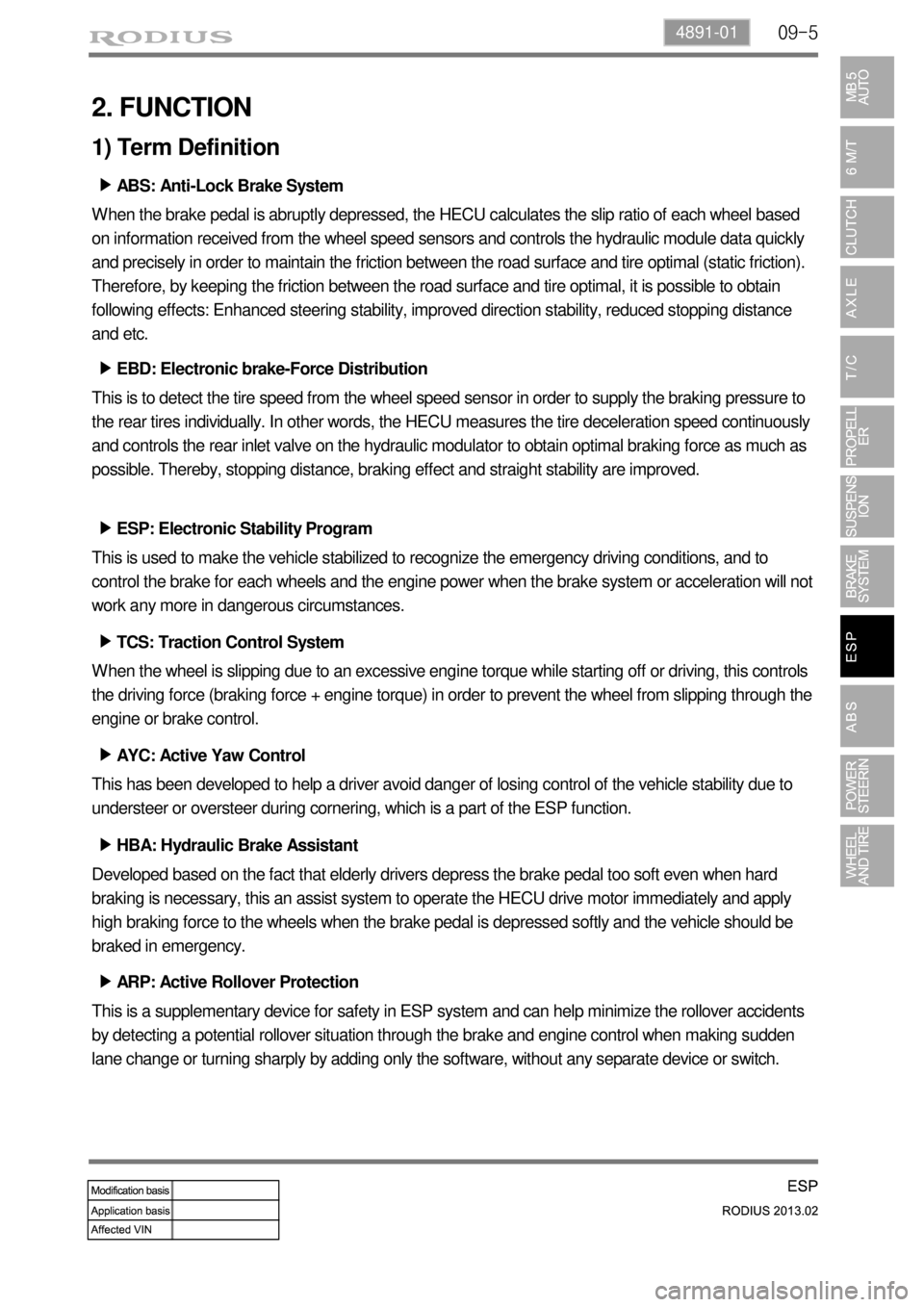
09-54891-01
2. FUNCTION
1) Term Definition
ABS: Anti-Lock Brake System ▶
When the brake pedal is abruptly depressed, the HECU calculates the slip ratio of each wheel based
on information received from the wheel speed sensors and controls the hydraulic module data quickly
and precisely in order to maintain the friction between the road surface and tire optimal (static friction).
Therefore, by keeping the friction between the road surface and tire optimal, it is possible to obtain
following effects: Enhanced steering stability, improved direction stability, reduced stopping distance
and etc.
EBD: Electronic brake-Force Distribution ▶
This is to detect the tire speed from the wheel speed sensor in order to supply the braking pressure to
the rear tires individually. In other words, the HECU measures the tire deceleration speed continuously
and controls the rear inlet valve on the hydraulic modulator to obtain optimal braking force as much as
possible. Thereby, stopping distance, braking effect and straight stability are improved.
ESP: Electronic Stability Program ▶
This is used to make the vehicle stabilized to recognize the emergency driving conditions, and to
control the brake for each wheels and the engine power when the brake system or acceleration will not
work any more in dangerous circumstances.
TCS: Traction Control System ▶
When the wheel is slipping due to an excessive engine torque while starting off or driving, this controls
the driving force (braking force + engine torque) in order to prevent the wheel from slipping through the
engine or brake control.
AYC: Active Yaw Control ▶
This has been developed to help a driver avoid danger of losing control of the vehicle stability due to
understeer or oversteer during cornering, which is a part of the ESP function.
HBA: Hydraulic Brake Assistant ▶
Developed based on the fact that elderly drivers depress the brake pedal too soft even when hard
braking is necessary, this an assist system to operate the HECU drive motor immediately and apply
high braking force to the wheels when the brake pedal is depressed softly and the vehicle should be
braked in emergency.
ARP: Active Rollover Protection ▶
This is a supplementary device for safety in ESP system and can help minimize the rollover accidents
by detecting a potential rollover situation through the brake and engine control when making sudden
lane change or turning sharply by adding only the software, without any separate device or switch.
Page 652 of 796
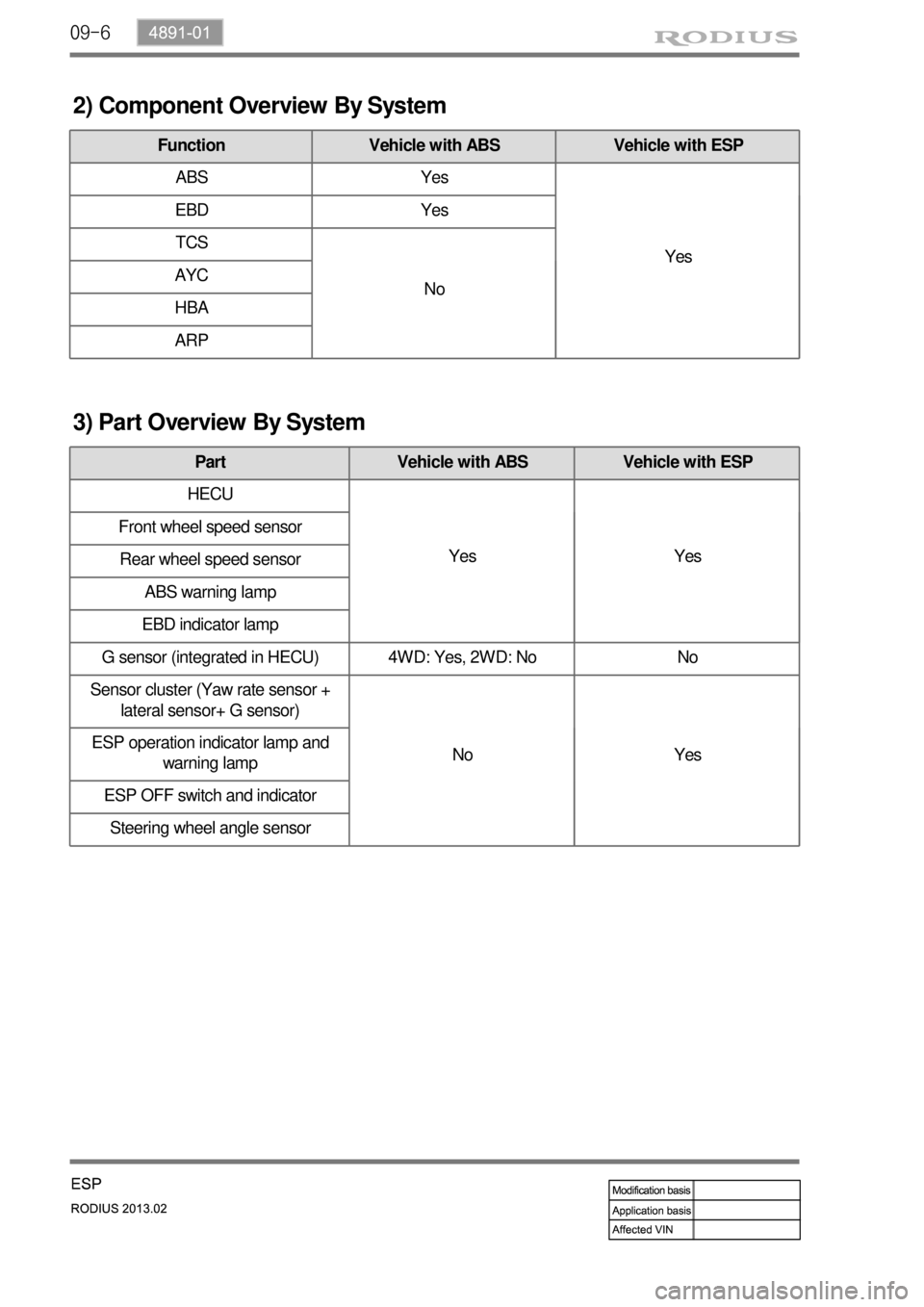
09-6
2) Component Overview By System
Function Vehicle with ABS Vehicle with ESP
ABS Yes
Yes EBD Yes
TCS
No AYC
HBA
ARP
3) Part Overview By System
Part Vehicle with ABS Vehicle with ESP
HECU
Yes Yes Front wheel speed sensor
Rear wheel speed sensor
ABS warning lamp
EBD indicator lamp
G sensor (integrated in HECU) 4WD: Yes, 2WD: No No
Sensor cluster (Yaw rate sensor +
lateral sensor+ G sensor)
No Yes ESP operation indicator lamp and
warning lamp
ESP OFF switch and indicator
Steering wheel angle sensor
Page 654 of 796
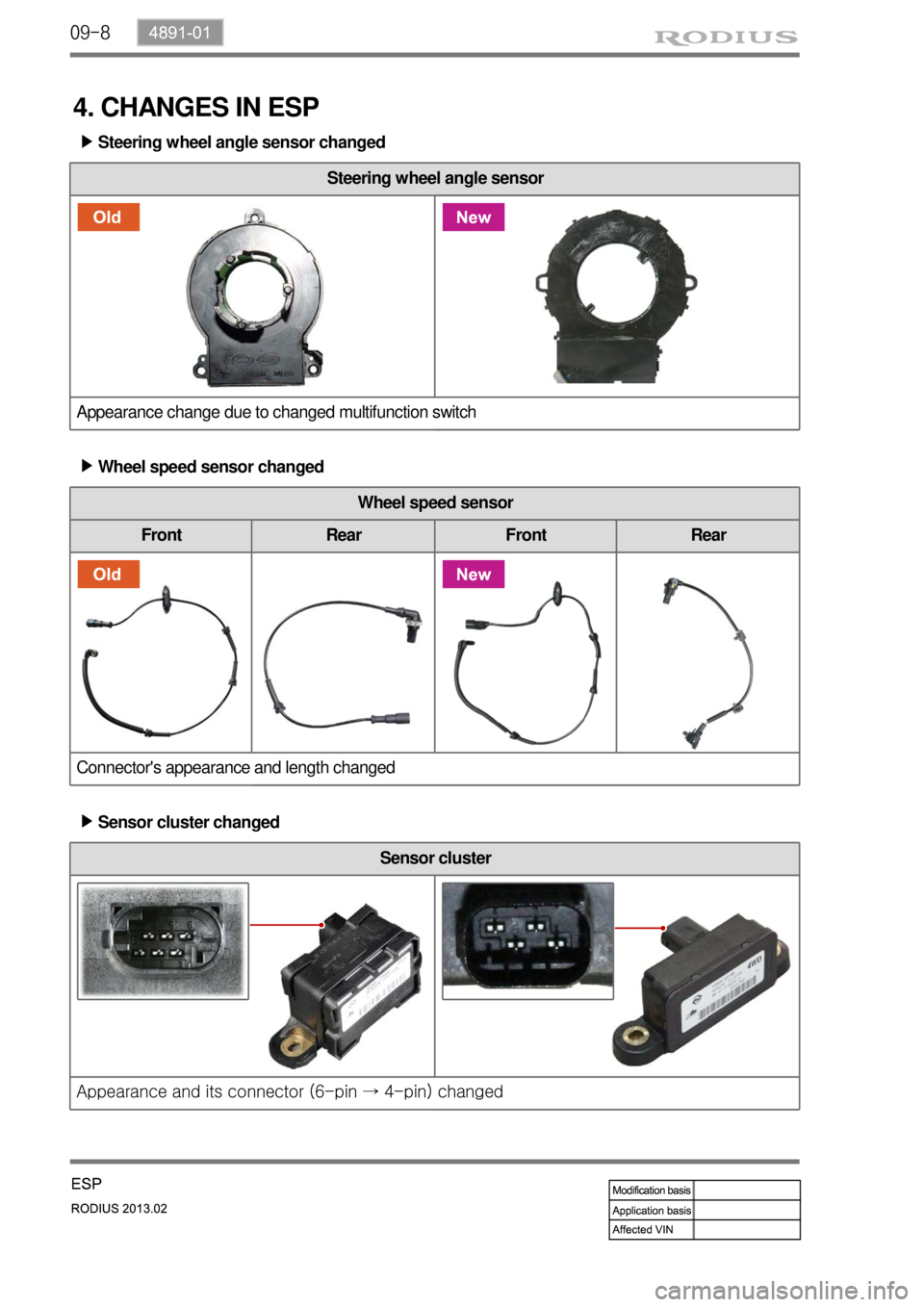
09-8
Steering wheel angle sensor
Appearance change due to changed multifunction switch
4. CHANGES IN ESP
Steering wheel angle sensor changed ▶
Wheel speed sensor changed ▶
Wheel speed sensor
Front Rear Front Rear
Connector's appearance and length changed
Sensor cluster changed ▶
Sensor cluster
Appearance and its connector (6-pin → 4-pin) changed
Page 655 of 796
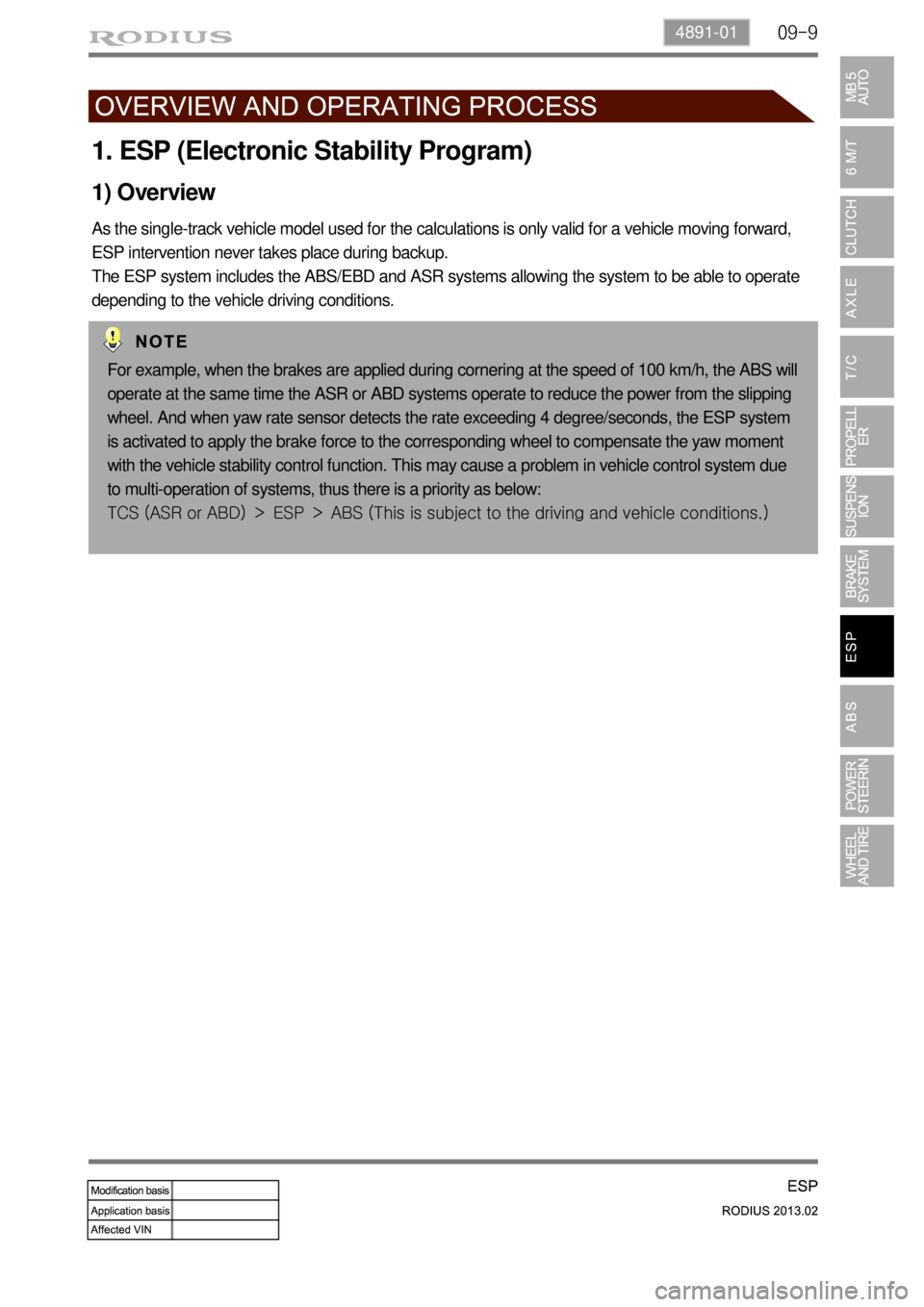
09-94891-01
1. ESP (Electronic Stability Program)
As the single-track vehicle model used for the calculations is only valid for a vehicle moving forward,
ESP intervention never takes place during backup.
The ESP system includes the ABS/EBD and ASR systems allowing the system to be able to operate
depending to the vehicle driving conditions.
1) Overview
For example, when the brakes are applied during cornering at the speed of 100 km/h, the ABS will
operate at the same time the ASR or ABD systems operate to reduce the power from the slipping
wheel. And when yaw rate sensor detects the rate exceeding 4 degree/seconds, the ESP system
is activated to apply the brake force to the corresponding wheel to compensate the yaw moment
with the vehicle stability control function. This may cause a problem in vehicle control system due
to multi-operation of systems, thus there is a priority as below:
TCS (ASR or ABD) > ESP > ABS (This is subject to the driving and vehicle conditions.)
Page 656 of 796
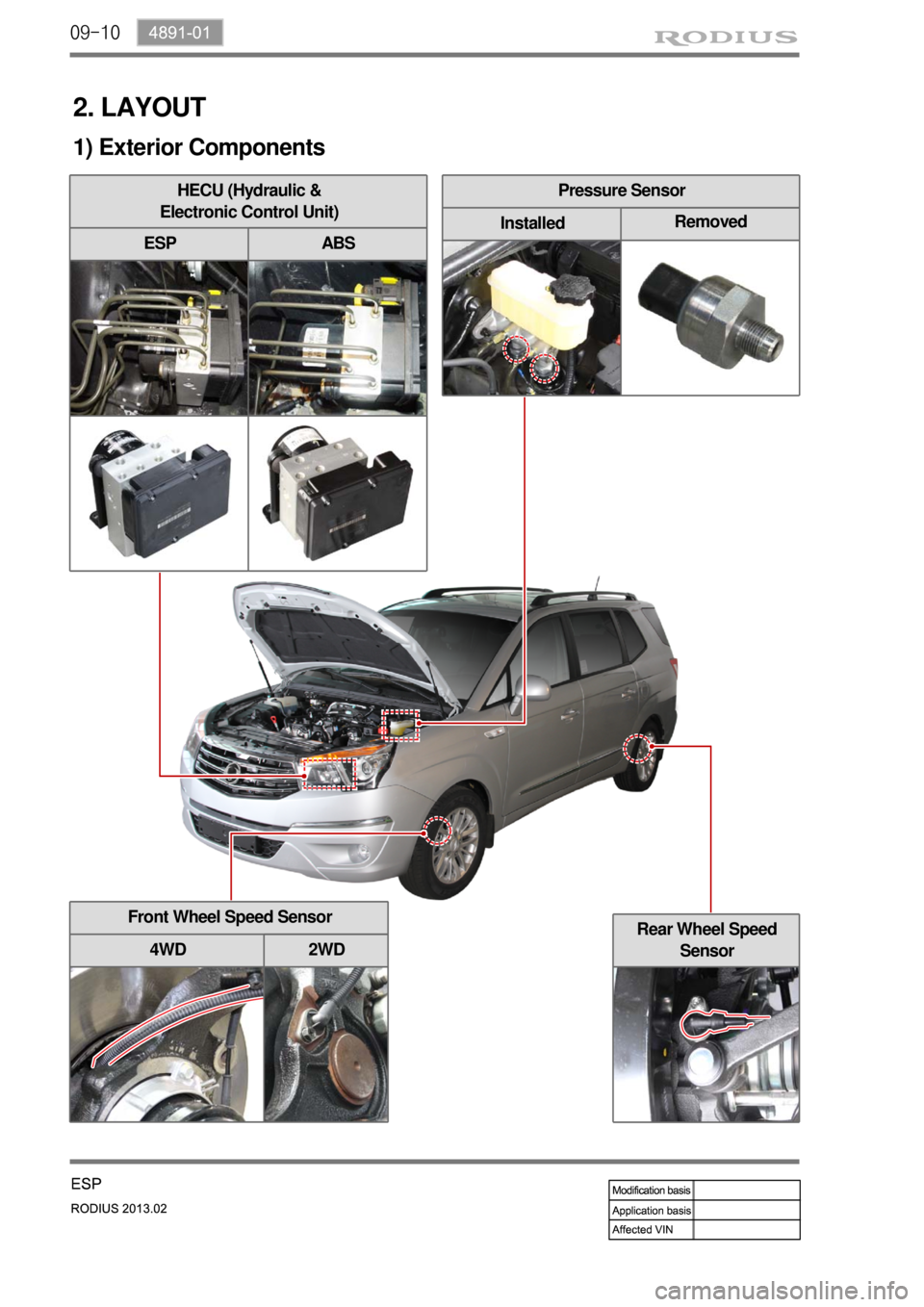
09-10
Pressure Sensor
InstalledRemoved
2. LAYOUT
HECU (Hydraulic &
Electronic Control Unit)
ESP ABS
Front Wheel Speed Sensor
4WD 2WDRear Wheel Speed
Sensor
1) Exterior Components